Tag Archives for Electric Cars
Cramming cities full of electric vehicles means we’re still depending on cars — and that’s a huge problem
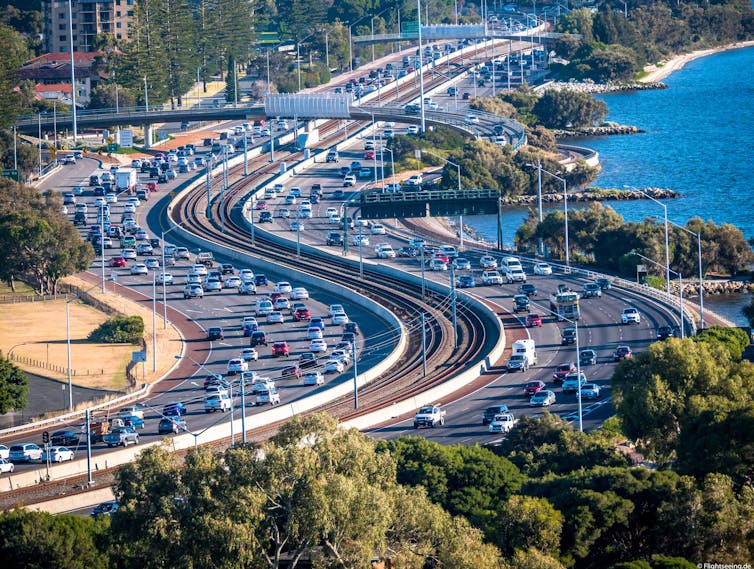
Shutterstock
Kurt Iveson, University of SydneyThis week, the NSW government announced almost A$500 million towards boosting the uptake of electric vehicles. In its new electric vehicle strategy, the government will waive stamp duty for cars under $78,000, develop more charging infrastructure, offer rebates to 25,000 drivers, and more.
Given the transport sector is Australia’s second-largest polluter, it’s a good thing Australian governments are starting to plan for a transition to electric vehicles (EVs).
But transitioning from cities full of petrol-guzzling vehicles to cities full of electric ones won’t address all of the environmental and social problems associated with car dependence and mass manufacturing.
So, let’s look at these problems in more detail, and why public transport really is the best way forward.
Mounting disadvantage and health issues
EVs do have environmental advantages over conventional vehicles. In particular, they generate less carbon emissions during their lifetime. Of course, much of the emissions reductions will depend on how much electricity comes from renewable sources.
But carbon emissions are only one of the many problems associated with the dominance of private cars as a form of mobility in cities.
Let’s start with a few of the social issues. This includes the huge amount of space devoted to car driving and parking in our neighbourhoods. This can crowd out other forms of land use, including other more sustainable forms of mobility such as walking and cycling.
There are the financial and mental health costs of congestion, as well, with Australian city workers spending, on average, 66 minutes getting to and from work each day. Injuries and fatalities on roads are also increasing, and inactivity and isolation associated with driving can impact our physical health.
Car-dependent cities also contribute to disadvantage for people who don’t have access to cars, and uneven financial vulnerability associated with the high costs of car ownership and use.
Indeed, some of these problems could be made worse — for instance, subsidies for EVs could end up favouring wealthier people who can afford new cars.
Read more:
Top economists call for budget measures to speed the switch to electric cars
Mining for resources
A mass global uptake of EVs will generate major environmental problems, too. Most concerning of these is the use of finite mineral resources required for their construction, and the environmental and labour conditions of their extraction.
This was recently highlighted in a recent report by the International Energy Agency. As the agency’s executive director Fatih Birol said, there’s a
looming mismatch between the world’s strengthened climate ambitions and the availability of critical minerals that are essential to realising those ambitions.
Minerals such as lithium, cobalt, nickel and copper are key ingredients required to make EVs.
As the report noted, EVs use double the amount of copper than conventional vehicles. EVs also require considerable amounts of lithium, cobalt and graphite that are hardly required at all for conventional vehicles. And it expects demand for lithium to grow 40-fold between 2020 and 2040, driven by EV production to meet climate targets.

Shutterstock
There is considerable discussion of Australia’s natural advantage as a supplier of some of these minerals, as we have large reserves of lithium and rare-earth metals beneath parts of the continent.
But before governments and mining bodies rush to exploit these reserves, they need to ensure much more is done to avoid the injustices perpetrated against Traditional Owners and their lands and heritage. The recent appalling destruction at Juukan Gorge by Rio Tinto’s iron ore operation is just one example of this.
Read more:
Rio Tinto just blasted away an ancient Aboriginal site. Here’s why that was allowed
Mining also has its own environmental problems, such as land clearing and associated biodiversity loss, the pollution and contaminants it produces, and intensive water use.
The conditions of extracting these critical minerals in other parts of the world are dire. There’s the oppressive working conditions in cobalt mining in the Democratic Republic of the Congo, the conflict over Indigenous rights in Chile’s lithium mining areas, and environmental destruction associated with mining rare earth minerals in China.
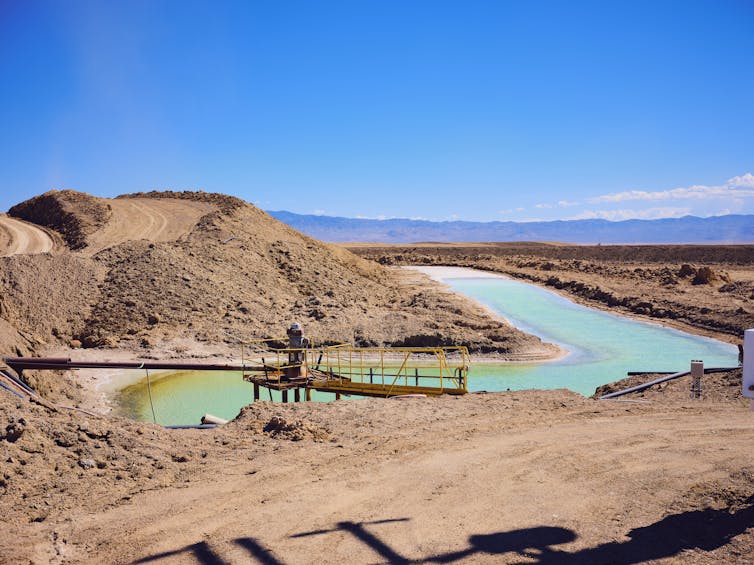
Shutterstock
Broadening ideas about transport
To focus on these problems is not to suggest the new policies on electric vehicles are unimportant, or that they don’t stand to have some positive environmental impact.
The point is private EVs are not a solution to the combined challenges of reducing our urban environmental footprints and making better cities for all, and they have their own problems.
Instead, we should develop a good mass public transport system with extensive and frequent coverage. Alongside urban development with a more even distribution of jobs, services and opportunities, investing in better public transport could reduce car dependence in our cities.
This would have a range of environmental and social benefits: making more space available for people instead of machines, extending the benefits of mobility to people who can’t or don’t drive, and reducing demand for finite minerals.
Even fossil-fuelled public transport has fewer emissions than conventional car travel. Data from the Intergovernmental Panel on Climate Change shows the most fuel-efficient buses and trains generate less than half the carbon emissions per passenger kilometre of fuel-efficient cars. Of course, public transport powered by renewables will be even better.
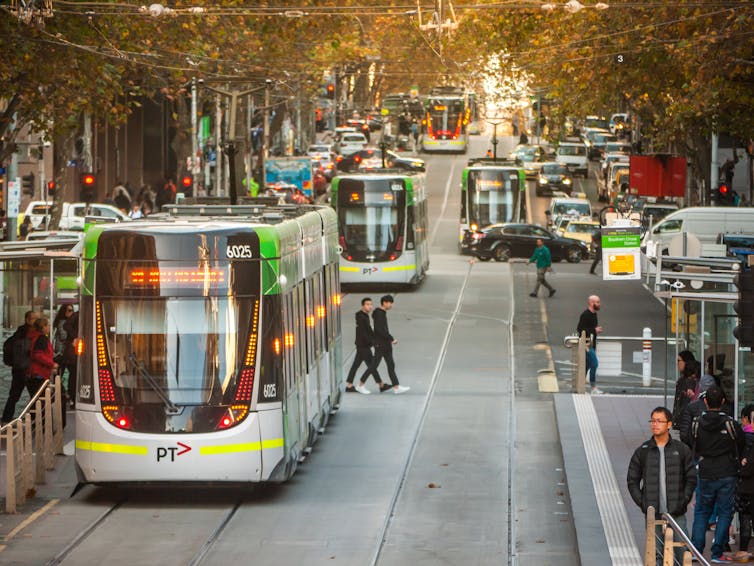
Shutterstock
But as things stand, we are far from having such a city. The benefits of good public transport and public services are unevenly distributed across our cities.
In Sydney, for example, there are significant investments in new public transport infrastructure in some parts of the city, such as Metro West and the recently completed North West Metro. There are welcome commitments to reduce emissions in that sector, too.
But we’re a long way from planning new developments and redevelopments to make public transport a viable alternative to cars. The lack of public transport infrastructure in newly constructed, master-planned estates on Sydney’s urban fringe is the most glaring example.
Read more:
Climate explained: the environmental footprint of electric versus fossil cars
Ultimately, it’s important that a transition to electric vehicles doesn’t dominate the discussion we need to have about urban transport.
Our challenge is to simultaneously reduce the carbon footprint of different forms of transport, while also thinking much more broadly about the sustainability and justice of the system of mobility that’s so central to daily life in our cities.![]()
Kurt Iveson, Associate Professor of Urban Geography and Research Lead, Sydney Policy Lab, University of Sydney
This article is republished from The Conversation under a Creative Commons license. Read the original article.
Top economists call for budget measures to speed the switch to electric cars

Wes Mountain/The Conversation, CC BY-ND
Peter Martin, Crawford School of Public Policy, Australian National UniversityAustralia’s top economists overwhelmingly back government measures to speed the transition to electric cars in order to meet emission reduction targets.
An exclusive poll of 62 of Australia’s preeminent economists — selected by their peers — finds 51 back measures to boost the take-up of electric cars including subsidising public charging stations, subsidising the purchase of all-electric vehicles, and setting a date to ban the import of traditionally-powered cars.
Only 11 oppose such measures, three of them because they prefer a carbon tax.
Six of the 51 who supported special measures said they did so reluctantly, as their preferred alternative would be a carbon price or a carbon tax, rather than subsidising “one alternative out of many to reduce emissions”.
Cars account for roughly half of Australia’s transport emissions, making them about 8% of Australia’s total emissions.
Yet Australia’s take-up of electric vehicles is dwarfed by the rest of the world.
On one measure, all-electric cars accounted for just 0.7% of new car sales in Australia in 2020 compared to 5% in China and 3.5% in the European Union.
Australia has no domestic car industry to protect, meaning industry policy concerns needn’t hold back the transition.
Read more:
Going electric could be Australia’s next big light bulb moment
Norway plans to outlaw new petrol car sales from 2025; Denmark, the Netherlands, Ireland and Israel from 2030; and California and Britain from 2035.
Asked whether Australia should take action to speed the transition, eight in ten of the 62 economists selected by the Economic Society said it should.
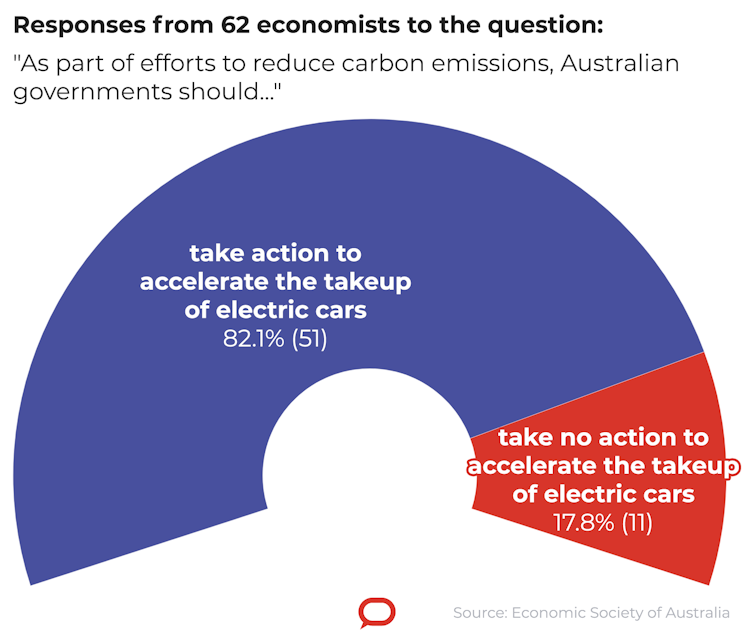
Economic Society of Australia/The Conversation, CC BY-ND
The results represent a departure for a profession whose usual advice is to avoid interfering with markets.
One participant, University of NSW professor Gigi Foster said an important question needed to be answered in order to justify government intervention: “what is the market failure here?”
The market failure was pollution, imposing costs on the community beyond the drivers of conventionally-powered cars and on the planet by pushing up global temperatures.
Broad support: subsidies for charging points
If it wasn’t to be dealt with by a carbon price, measures that sped up the switchover to electric vehicles could achieve some of the same effect.
By far the most popular measure of six presented to the panellists who supported government action was subsidising public charging points, backed by 84%.
The next most popular was removing the luxury car tax from electric-only vehicles. At present the 35% tax applies to cars valued at more than $69,152, and $79,659 for fuel-efficient vehicles.
43% supported making charging points compulsory in new homes and new car parks. 39% supported setting a date to ban the import of petrol and diesel cars.
Matthew Butlin, who chairs South Australia’s Productivity Commission, noted that much of Australia was not urban and unlikely to be served by charging points for some time.
Without government measures to speed the installation of remote charging stations, many buyers would be reluctant to go electric, even if most of their driving was in cities.
When they were in place, there would be a good case for banning the import of petrol and diesel vehicles, but not until then.
Read more:
Could electric car batteries feed power back into the grid?
Others wanted to hold off on banning the import of conventionally-powered cars until Australia had a lower-emissions mix of electricity.
Macquarie University’s Lisa Magnani said that with three quarters of Australia’s electricity generated from coal, electric vehicles created considerable emissions.
The Grattan Institute’s Danielle Wood disagreed, saying “network effects” built a case for switching over early.
Network effects build on themselves
The more people switched, the more charging stations would be built and the lower electric vehicle prices would drop, driving more people to switch, and increasing the benefits of decarbonising the electricity supply.
The sooner Australia swapped over, the easier it would be to get to net zero emissions by 2050 without the need for a “cash for clunkers” style scheme to buy back polluting vehicles.
Setting 2035 as the date for banning imports of petrol-powered cars as recommended this year by the International Energy Agency would give buyers time to adjust while the charging infrastructure developed.
Read more:
Want an electric car? Here’s how to buy second-hand
Tax specialist John Freebairn said electric cars were already heavily subsidised by escaping the fuel excise used to fund roads, despite the efforts of some states to plug the gap.
Sydney University economist Stefanie Schurer argued on the other hand bulky and polluting sport utility vehicles were effectively subsidised because of the tax benefits they attracted when used for work.
Former Liberal Party leader John Hewson of the Crawford School of Public Policy said smoothing the transition had become urgent.
Smooth transition now “urgent”
It took only ten years from 1903-13 for the United States to switch from horse-drawn to petrol-driven vehicles, and technology take-up was quicker today, particularly in Australia.
Other economists surveyed noted that there was much that could be done to reduce harmful emissions in addition to going electric.
Sue Richardson said Australia should impose serious limits on the tailpipe emissions of new cars. Australia is unusual among developed nations in not having such a limit, making it a favoured market for high-emission cars.
Read more:
The trucking industry has begun to turn electric; cars will take longer
Rana Roy said a better approach would be to limit transport itself through remote working and efforts to encourage walking and cycling. Subsidies for electric cars could send such moves backwards.
When responses to the survey were weighted by the confidence respondents had in them on a scale of 1 to 10, support of special measures to drive the transition remained about as strong, backed by eight in ten of the economists surveyed.
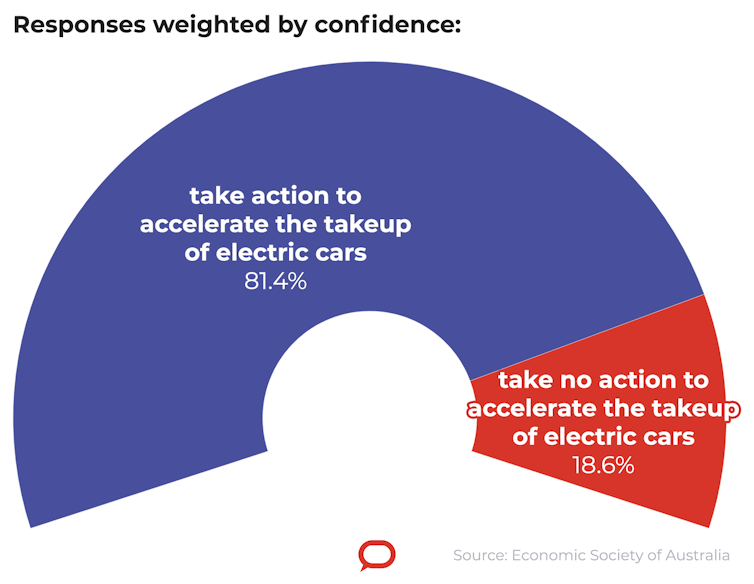
Economic Society of Australia/The Conversation, CC BY-ND
Detailed responses:
![]()
Peter Martin, Visiting Fellow, Crawford School of Public Policy, Australian National University
This article is republished from The Conversation under a Creative Commons license. Read the original article.
Check your mirrors: 3 things rooftop solar can teach us about Australia’s electric car rollout

Shutterstock
Bjorn Sturmberg, Australian National University; Kathryn Lucas-Healey, Australian National University; Laura Jones, Australian National University, and Mejbaul Haque, Australian National UniversityGovernments and car manufacturers are investing hundreds of billions of dollars on electric vehicles. But while the electric transport revolution is inevitable, the final destination remains unknown.
The electric vehicle transition is about more than just doing away with vehicles powered by fossil fuels. We must also ensure quality technology and infrastructure, anticipate the future and avoid unwanted outcomes, such as entrenching disadvantage.
In Australia, the electric vehicle rollout has been slow, and federal action limited. But some state governments are working to electrify bus fleets, roll out public charging networks and trial smart vehicle charging in homes.
Australia’s world-leading rollout of rooftop solar power systems offers a guide to help navigate the transition. We’ve identified three key lessons on what’s gone well, and in hindsight, what could have been done differently.

Shutterstock
1. Price isn’t everything
Solar systems and electric vehicles are both substantial financial investments. But research into rooftop solar has shown financial considerations are just one factor that guides purchasing decisions. Novelty, concerns about climate change and a desire for self-sufficiency are also significant – and electric vehicle research is producing similar findings.
When considering the electric vehicle rollout, understanding these deeper motivators may help avoid a race to the bottom on price.
About one in four Australian homes has rooftop solar, with almost three million systems installed. Solar companies have often sought to highlight the low price of rooftop systems over other considerations. This has created consumer demand for low-priced, lower-quality products – and led to potentially hundreds of thousands of substandard installations across Australia.
So what are the lessons here for the electric vehicle rollout? First, when planning public infrastructure where electric vehicles can be charged, construction costs should not be the only consideration. Factors such as night-time safety and disability access should be prioritised. Shortcuts today will reinforce barriers for women and people with disabilities and create complex problems down the track.
Like rooftop solar, the point of sale of electric vehicles offers a unique opportunity to teach customers about the technology. Companies, however, can only afford to invest in customer education if they aren’t too stressed about margins.
“Smart” charging is one measure being explored to ensure the electricity network can handle future growth in electric vehicle uptake. Smart chargers can be remotely monitored and controlled to minimise their impact on the grid.
The point of sale is a pivotal moment to tell new owners of electric vehicles that their charging may at times be managed in this way.
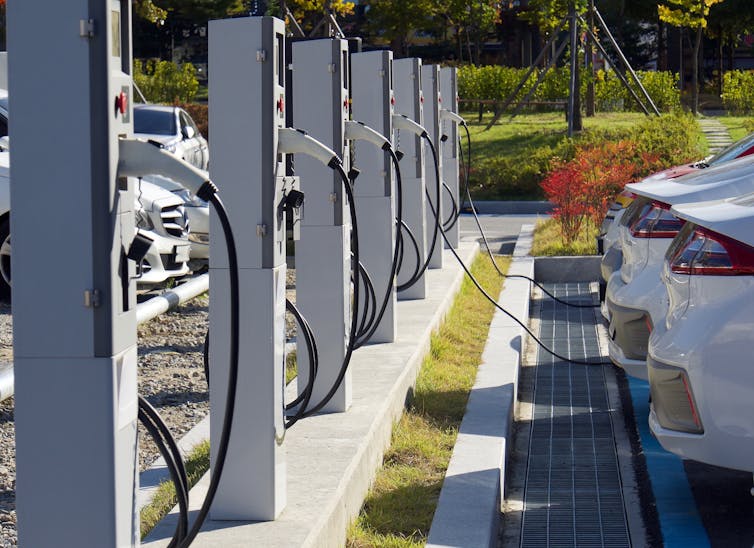
Shutterstock
2. Plan ahead
The uptake of rooftop solar in Australia has been a raging success. In fact, rooftop solar is now the largest generator in the national power system.
This raises issues, such as how rooftop solar systems will respond to a major disturbance, such as the failure of a transmission line. A large amount of solar power feeding into the grid can also challenge electricity network infrastructure.
In response, electricity networks have implemented changes such as limiting solar exports and therefore, returns to solar system owners, and charging fees for exporting solar.
Such retrospective changes have been unpopular with solar owners. So to maintain reliable electricity supplies, and avoid angering consumers, it’s vital to plan where and when electric vehicles are charged.
If every vehicle in Australia was electric, this would add about a quarter to national power demand. The rise in demand would be greatest near bus and logistics depots and ultra-fast highway chargers.
Read more:
Owners of electric vehicles to be paid to plug into the grid to help avoid blackouts
Timing is key to maximising the use of a network connection without overloading it. For example, if everyone charged their vehicle in the evening after they get home from work, as this would put further pressure on electricity supplies at this peak time.
Governments and electricity providers should encourage electric vehicle charging during the day, when demand is lower. This might mean, for example, providing vehicle charging facilities at workplaces and in public areas.
Until Australia’s power grid transitions to 100% renewables, the use of solar energy should be strongly encouraged. This would ensure the vehicles were charged from a clean, cheap energy source and would help manage the challenges of abundant solar.
The question of road user charges for electric vehicles drivers is another example where it’s best to avoid retrospective changes. Such charges are necessary in the long run and best introduced from the outset.
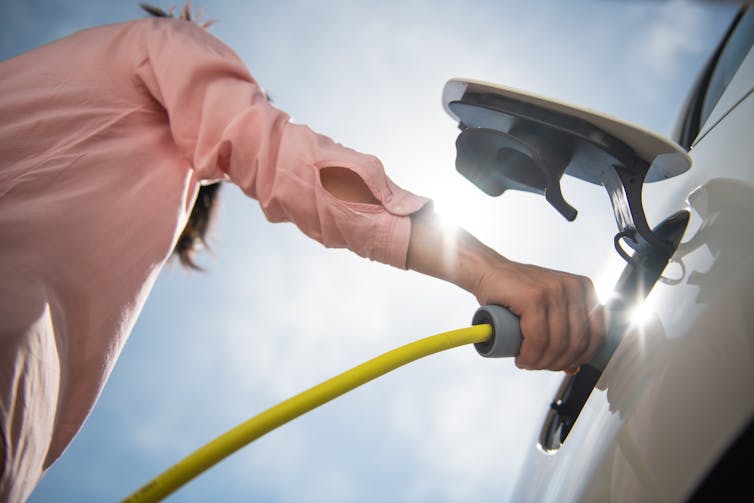
Shutterstock
3. Coordination is key
Electric vehicle policy spans many government portfolios: transport, infrastructure, energy, planning, environment and climate change. Nationally, and from state to state, different ministers are in charge.
This makes coordination difficult, and creates the risk of policies undermining each other. For example, one policy might encourage the charging of electric vehicles from rooftop solar, to reduce carbon emissions. But because solar energy is so cheap, this might encourage more private vehicle use, which worsens road congestion.
So policies to encourage electric vehicle uptake should not come at the cost of creating more attractive and efficient public transport networks.
And new technologies can entrench societal disadvantage. For example, the rooftop solar rollout often excluded people who could not afford to buy the systems. Without policies to address this, the electric vehicle transition could lead to similar outcomes.
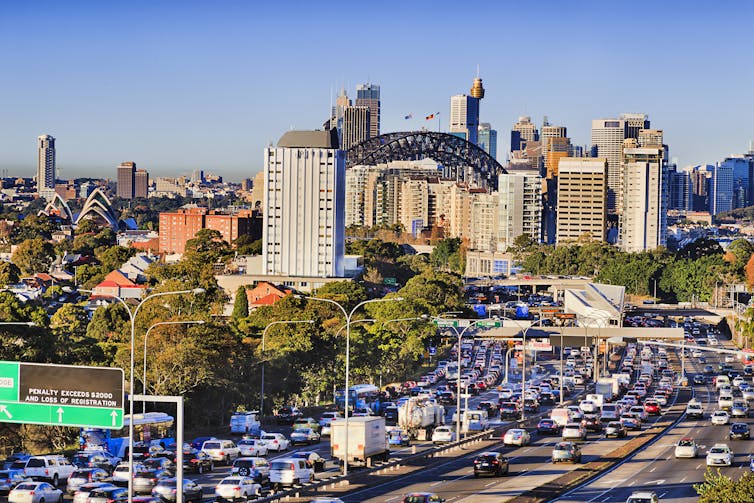
Shutterstock
Lessons in the rear-view mirror
As Australia’s experience with rooftop solar has shown, successful technology transitions must be carefully planned and attentively steered.
In the case of electric vehicles, this will ensure the benefits to owners, society and the environment are fully realised. It will also ensure a smooth-as-possible transition, the gains from which all Australians can share.
Read more:
The US jumps on board the electric vehicle revolution, leaving Australia in the dust
![]()
Bjorn Sturmberg, Research Leader, Battery Storage & Grid Integration Program, Australian National University; Kathryn Lucas-Healey, Research Fellow, Australian National University; Laura Jones, Senior Analyst – Economics and Business models, Australian National University, and Mejbaul Haque, Research Fellow, Battery Energy Storage and Grid Integration Program, Research School of Engineering, Australian National University
This article is republished from The Conversation under a Creative Commons license. Read the original article.
Don’t forget the need for zero-emission buses in the push for electric cars

John Stone, The University of Melbourne; Iain Lawrie, The University of Melbourne, and Nat Manawadu, The University of MelbourneAs part of efforts to decarbonise urban transport, Australian states and the ACT have announced various zero-emission bus trials and targets for replacing diesel buses. These trials are designed to help resolve some of the complex technical and contractual issues facing bus operators and public transport agencies.
It is important to remember the vital role of buses, and public transport more generally, in decarbonising the transport sector — Australia’s third-largest source of greenhouse gas emissions. We fear this point has been lost in recent climate advocacy highlighting the slow pace of the transition to green propulsion for private cars in Australia.
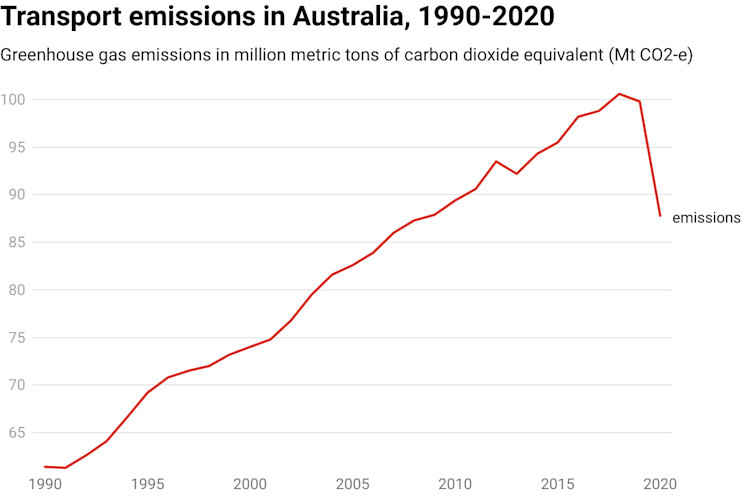
Chart. The Conversation. Data: National Greenhouse Gas Inventory Quarterly Update December 2020, CC BY
Read more:
Transport is letting Australia down in the race to cut emissions
Our research aims to learn more about the obstacles to an effective transition to zero-emission buses. We are engaging mainly with groups connected with the trial announced by the Victorian Department of Transport in late 2020, but the issues are similar across Australia.
Why can’t we rely on electric cars?
Even if Australia’s transition to green-electric cars is successful, the climate benefits will be less than we need. The carbon costs of manufacturing replacements for Australia’s 20 million-strong vehicle fleet will be equivalent to around 20 years’ emissions from Australia’s dirtiest brown coal generator at Yallourn. And tonnes of concrete and bitumen will continue to be laid for new toll roads and car parks.
A city of electric vehicles will also perpetuate the fatal burdens of car dependence: urban sprawl, inequitable access to the riches of city life, suppression of cycling and walking, and a host of health risks ranging from physical inactivity to air pollution. Even if exhausts were cleaner, recent UK research shows a significant proportion of damaging particulates come from worn tyres and brake linings.
To protect the climate and to make city life safer, fairer and healthier, we need policies that take cars off the roads, regardless of how they are fuelled.
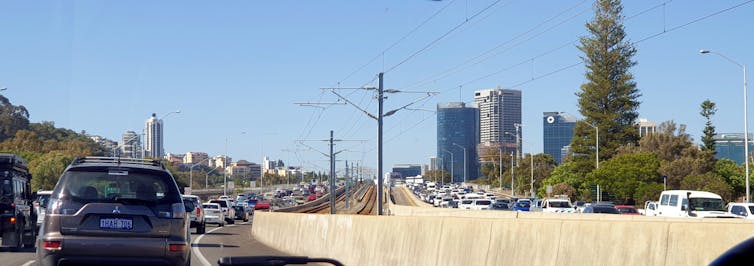
Orderinchaos/Wikimedia Commons, CC BY-SA
Read more:
Think taxing electric vehicle use is a backward step? Here’s why it’s an important policy advance
Bus services are under-utilised — we can fix that
The technical complexities of the transition to zero-emission buses could, if we are not careful, lead governments to lose sight of this bigger picture. Buses can help reduce demand for car travel, but only if they operate as effective links in a seamless public transport network.
In Melbourne, for example, many buses run almost empty. Routes are convoluted and services infrequent. It would be a travesty to invest millions in moving to greener buses without improving services in ways that increase patronage.
We can use internationally proven techniques to restructure the network so buses provide practical and convenient alternatives to the car. We can then attract a new generation of riders who currently think that “buses are not for me”. This is achievable within current Australian urban densities.
Read more:
Why cities planning to spend billions on light rail should look again at what buses can do
What other challenges must be overcome?
The first technical challenge is to decide between electric battery and hydrogen power. Most governments are leaning towards batteries. This is largely because the technology and its support systems are more evolved.
However, not all battery buses are created equal. One configuration might work well for a bus that will operate on short routes and can easily return to base to recharge. A bus that will operate on longer or steeper routes might need a different set-up. Operators will need to understand these trade-offs before they order new vehicles.
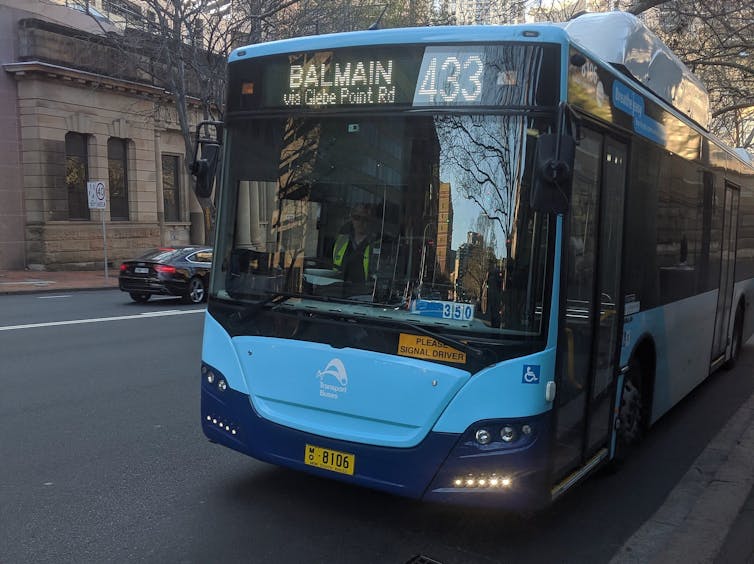
MDRZ/Wikimedia Commons, CC BY-SA
As established supply chains and cost structures for fossil fuels become obsolete, operators will also need to come to grips with the intricacies of Australia’s electricity market. At the same time, the power industry is grappling with new forecasts for demand and the infrastructure required for secure supply. Added to this, there are fears of a repeat of the “gold-plating” by private energy providers and distributors that has plagued the industry in recent years.
The change of power source also creates new challenges for fleet managers. If the transition takes several years, how will an operator manage the changing demands on depot space for refuelling and maintenance? Are depots in the right locations for new patterns of refuelling and deployment? How will the workforce gain the new skills they will need?
Issues won’t be resolved overnight
These issues and other technical questions can certainly be resolved. However, the institutional framework in which this must occur makes it hard to imagine it can be done quickly.
In Melbourne, buses operate under more than 15 different contracts, some with multinationals and others with tiny family businesses. These contracts vary in their provisions for determining routes and frequencies, for fleet and depot ownership, and for rollover or re-tendering. This complexity is a historical legacy compounded by decades of political and bureaucratic inertia.
The challenge for governments is to find a path to introducing zero-emission buses and reforming bus networks that deals with the technical uncertainties and the allocation of cost and risk in a fragmented market. The arrival of new commercial players — offering combined bus procurement, operation, charging infrastructure and energy supply — makes the market all the more complex. Nevertheless, success is crucial for the climate and for the health of our cities.
Read more:
Climate policy that relies on a shift to electric cars risks entrenching existing inequities
![]()
John Stone, Senior Lecturer in Transport Planning, The University of Melbourne; Iain Lawrie, PhD Candidate and Sessional Lecturer in Planning, The University of Melbourne, and Nat Manawadu, Research Assistant, Architecture, Building and Planning, The University of Melbourne
This article is republished from The Conversation under a Creative Commons license. Read the original article.
Going electric could be Australia’s next big light bulb moment
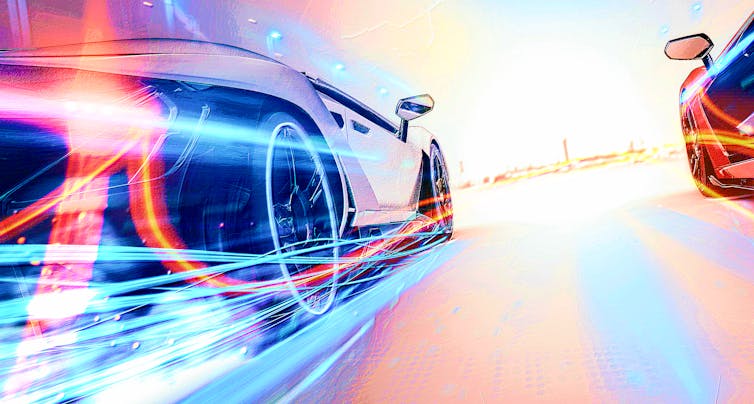
ParabolStudio/Shutterstock
Peter Martin, Crawford School of Public Policy, Australian National UniversityIn 2007 Malcolm Turnbull turned off an industry’s life support without blinking.
The industry made light bulbs, of the traditional kind; so energy-inefficient they lost most of it as heat.
“A normal light bulb is too hot to hold — that heat is wasted, and globally represents millions of tonnes of carbon dioxide that needn’t have been emitted,” he explained.
From February 2009 it became illegal to import the traditional pear-shaped globes, while from November that year it became illegal to sell them.
It was a world-first, announced by Turnbull as environment minister and sanctioned by his prime minister John Howard.
The European Union followed, and then, some years later, China.
Globally, electric lighting generated emissions equal to 70% of those from cars. Australia’s switch cut emissions by an estimated 4 million tonnes per year.

STILLFX/Shutterstock
Turnbull was able to do it because Australia no longer made light globes.
There was no domestic industry — and no jobs — to protect.
Australia stopped making cars in 2017. The thousands of workers who used to assemble cars in Australia no longer have those jobs.
Which means there’s no car industry to protect.
We have the opportunity to do to traditionally-powered cars what we did to incandescent light bulbs.
And the need. We’ve all but committed ourselves to net-zero emissions by 2050.
In a landmark report released last Tuesday, the International Energy Agency said the path to net-zero by 2050 was narrow and extremely challenging, requiring governments to “take action this year and every year after so that the goal does not slip out of reach”.
Many of the 400 or so milestones it set out are indeed challenging for Australia, among them no new coal mines or mine expansions from this year, and the closure of almost all of Australia’s coal-fired power stations by the end of this decade.
But one of the milestones ought to be easy.
It’s no new sales of internal combustion cars by 2035.
The rest of the world is racing ahead
As a step along the way, the agency wants two-thirds of all new cars sold to be petrol-free by 2030. Australia, with no vehicle production industry to care about, ought to get there sooner.
Norway has promised no new petrol car sales by 2025; Denmark, the Netherlands, Ireland and Israel by 2030; and California and the United Kingdom by 2035,
a target the UK has brought forward from 2040.
In addition, the European Union is imposing manufacturer-specific emissions targets, which will force each one to either sell a greater proportion of non-petrol vehicles or make the ones they do sell much more efficient.
Read more:
Costly, toxic and slow to charge? Busting electric car myths
Manufacturers are getting in early. Honda says it will sell only electric and hybrid vehicles in Europe starting in 2022, three years earlier than previously planned. Volvo says 50% of its worldwide sales will be fully electric by 2025 and the rest hybrids.
Like the transitions to colour TV, automatic car windows, automatic transmissions and transistor radios, the shift will be one way. When production lines are retooled, there will be no turning back.
Moving quickly would do more than help Prime Minister Scott Morrison produce a credible roadmap to take to Glasgow climate talks in November.
It would enable us to avoid becoming a dumping ground for the dirtier, more polluting vehicles that can’t be sold elsewhere while the changeover is underway.
Switching soon would save us money
And it would save the government money. It has just committed to pay up to A$2 billion to keep Australia’s two remaining oil refineries open until 2027.
Without the payments, Ampol might have closed Lytton in Queensland (it was weighing up doing so) and Viva Energy refinery might have closed its loss-making refinery at Geelong.
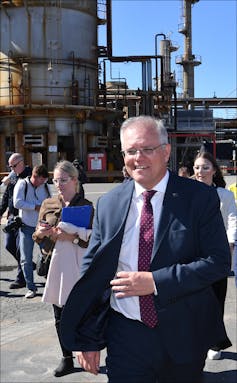
Darren England/AAP
While both have accepted the money, Ampol has unveiled plans to test the production of solar-powered hydrogen on its site at Lytton and Viva Energy is planning a solar farm on its site at Geelong.
Most of Australia’s petrol is imported, much of it from Singapore, meaning little would be lost if Australia’s refineries closed.
The Australian-produced fuel is dirtier than the imported fuel, something the Australian government promised to fix this month by paying Australia’s plants to make the ultra-low sulphur petrol the rest of the world switched to years ago.
If a ban on imports of petrol-powered cars wouldn’t much hurt Australia’s reluctant refiners, it might hurt petrol stations, but not much.
Australia’s service stations are in large measure retail convenience stores. They try to maximise “basket size”. Ampol plans to turn the petrol side of the business into a recharge and refuelling network for electric and hydrogen vehicles.
Mechanics would lose jobs
The much-larger industry at risk from a switch to electric vehicles is car maintenance. The Bureau of Statistics counts 352,200 automotive and engineering trades workers, almost all of them male and full time.
That a switch to low-maintenance electric vehicles would shrink their industry is unfortunate for them, but inevitable. Propping up their industry by delaying the transition would only encourage more young people into jobs with limited futures.

NLA Trove
When Australia switched from valve to transistor-operated TV sets in the 1970s, an army of “television repair men” was thrown out of business, along with their vans and two-way radios.
Most of them stayed in the workforce doing things we needed.
To have kept using sets requiring maintenance just to have kept them in work would have been an insult to them and us.
And while Australia’s switch away from incandescent globes was problematic (many of us liked the yellowish glow we’d become used to) the switch to electric cars is looking positively joyous.

Crikey/Coal Miners Driving Teslas
This week Crikey pointed to a video in which the Queensland MP Bob Katter gets his first taste of a Tesla as it accelerates from zero to 100 kilometres per hour in just over three seconds.
“Yeehaw!” he yells. “This is so exciting.”
Australians usually embrace the future. At times we’ve been ahead of it.
Read more:
International Energy Agency warns against new fossil fuel projects. Guess what Australia did next?
![]()
Peter Martin, Visiting Fellow, Crawford School of Public Policy, Australian National University
This article is republished from The Conversation under a Creative Commons license. Read the original article.
The budget should have been a road to Australia’s low-emissions future. Instead, it’s a flight of fancy
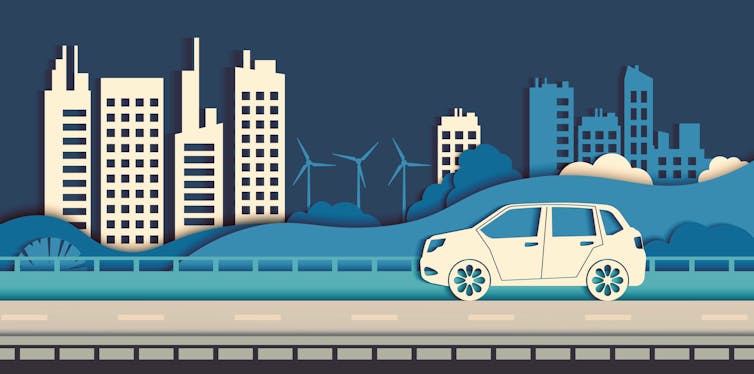
Shutterstock
John Quiggin, The University of QueenslandLooking at other nations around the world, the path to cutting greenhouse gas emissions seems clear.
First, develop wind and solar energy and battery storage to replace coal- and gas-fired electricity. Then, replace petrol and diesel cars with electric vehicles running off carbon-free sources. Finally, replace traditionally made steel, cement and other industries with low-carbon alternatives.
In this global context, the climate policies announced in Tuesday’s federal budget are a long-odds bet on a radically different approach. In place of the approaches adopted elsewhere, the Morrison government is betting heavily on alternatives that have failed previous tests, such as carbon capture and storage. And it’s blatantly ignoring internationally proven technology, such as electric vehicles.
The government could have followed the lead of our international peers and backed Australia’s clean energy sector to create jobs and stimulate the post-pandemic economy. Instead, it’s sending the nation on a fool’s errand.
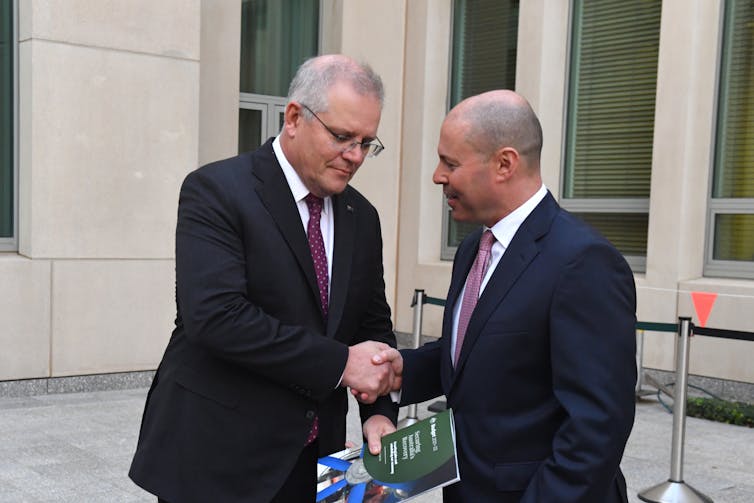
Mick Tsikas/AAP
Carbon-capture folly
The Morrison government is taking a “technology, not taxes” approach to emissions reduction. Rather than adopt a policy such as a carbon price – broadly considered the most effective and efficient way to cut emissions – the government has instead pinned its hopes on a low-emissions technology plan.
That means increased public spending on research and development, to accelerate the commercialisation of low emissions technologies. The problems with this approach are most obvious in relation to carbon capture and storage (CCS).
The budget contains A$263.7 million to fund new carbon capture and storage projects. This technology promises to capture some – but to date, not all – carbon dioxide at the point of emission, and then inject it underground. It would allow continued fossil fuel use with fewer emissions, but the process is complex and expensive.
In fact, recent research found of 39 carbon-capture projects examined in the United States, more than 80% ended in failure.
Read more:
The 1.5℃ global warming limit is not impossible – but without political action it soon will be
The government’s CCS funding is focused on capturing CO₂ from gas projects. This is despite the disappointing experience of Australia’s only CCS project so far, Chevron’s Gorgon gas field off Western Australia.
Some 80% of emissions from the operation were meant to be captured from 2016. But the process was delayed for three years, allowing millions of tonnes of CO₂ to enter the atmosphere. As of January this year, the project was still facing technical issues.
CCS from gas will be expensive even if it can be made to work. Santos, which has proposed a CCS project at its Moomba gas plant in South Australia, suggests a cost of $A30 per tonne of CO₂ captured.
This money would need to come from the government’s Climate Solutions Fund, currently allocated about A$2 billion over four years. If Moomba’s projected emissions reduction of 20 million tonnes a year were realised, this project alone would exhaust the fund.
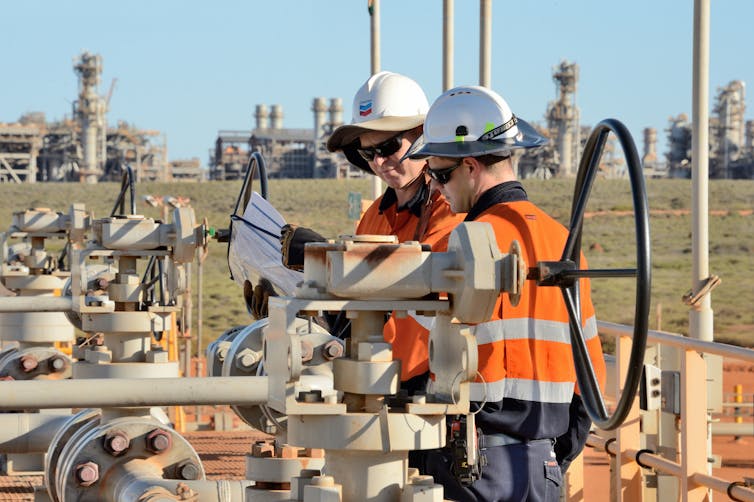
Chevron Australia
What about electric vehicles?
There is a striking contrast between the Morrison government’s enthusiasm for carbon capture, and its neglect of electric vehicles.
It ought to be obvious that if Australia is to achieve a target of net-zero emissions by 2050 – which Treasurer Josh Frydenberg this week reiterated was his government’s preference – the road transport sector must be decarbonised by then.
The average age of Australian cars is about 10 years. This implies, given fairly steady sales, an average lifespan of 20 years. This in turn implies most petrol or diesel vehicles sold after 2030 will have to be taken off the road before the end of their useful life.
In any case, such vehicles will probably be very difficult to buy within 15 years. Manufacturers including General Motors and Volvo have announced plans to stop selling petrol and diesel vehicles by 2035 or earlier.
But the Morrison government has ruled out consumer incentives to encourage electric vehicle uptake – a policy at odds with many other nations, including the US.
Read more:
The US jumps on board the electric vehicle revolution, leaving Australia in the dust
Despite the “technology, not taxes” mantra, this week’s federal budget ignored electric vehicles. This includes a A$10 billion infrastructure spend which did not include charging stations as part of highway upgrades.
Unless the government takes action soon, Australian motorists will be faced with the choice between a limited range of second-rate petrol and diesel vehicles, or electric vehicles for which key infrastructure is missing.
It’s hard to work out why the government is so resistant to doing anything to help electric vehicles. Public support appears strong. There are no domestic carmakers left to protect.
The car retail industry is generally unenthusiastic about electric vehicles. Its business model is built on combining competitive sticker prices with a high-margin service and repair business, and electric vehicles don’t fit this model.
At the moment (although not for much longer), electric vehicles are more expensive than traditional cars to buy upfront. But they are cheaper to run and service.
There are fears of job losses in car maintenance as electric vehicle uptake increases. However, car dealers have adjusted to change in the past, and can do so in future.
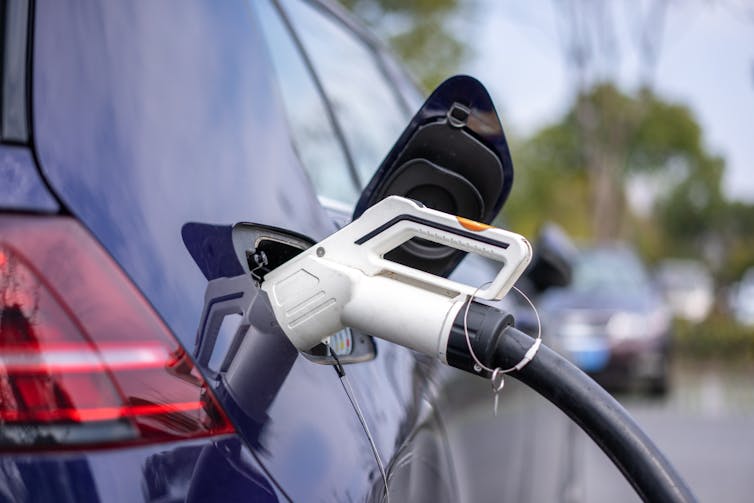
Shutterstock
Wishful thinking
The Morrison government is still edging towards announcing a 2050 net-zero target in time for the United Nations Climate Change Conference in Glasgow this November. But as Prime Minister Scott Morrison himself has emphasised, there’s no point having a target without a strategy to get there.
Yet at this stage, the government’ emissions reduction strategy looks more like wishful thinking than a road map.
John Quiggin, Professor, School of Economics, The University of Queensland
This article is republished from The Conversation under a Creative Commons license. Read the original article.
The trucking industry has begun to turn electric — but passenger vehicles will take a little longer
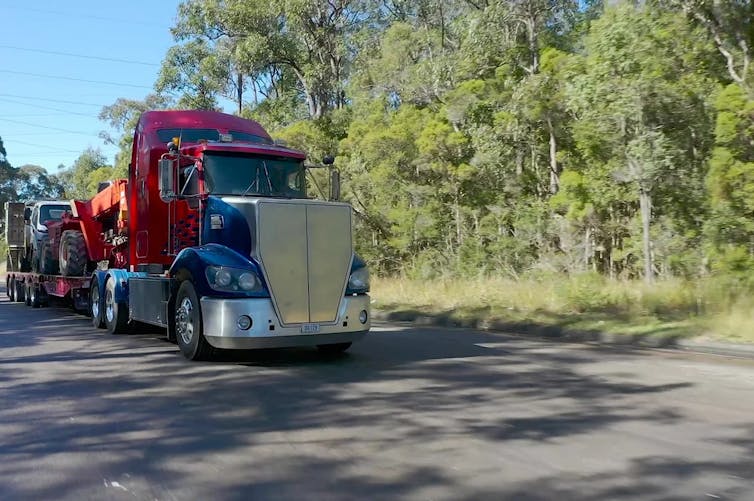
Janus Electric
Gail Broadbent, UNSW and Graciela Metternicht, UNSWAustralia’s trucking industry is making moves to go electric. The latest development — a system for using swappable batteries instead of time-consuming recharge stations for long-haul trucks between Sydney and Brisbane — shows how this transition is gathering momentum.
There will be clear socio-economic, environmental and health-related benefits from the switch to electric trucks — for the broader community as well as for the trucking industry and truckies themselves. As electric vehicle researchers, we think swappable batteries could work well for trucking, but are perhaps less suitable for everyday electric cars.
Electric trucking
There are many benefits from electrifying truck transport. Companies such as Woolworths and Ikea have already started to transition to electric delivery vans for the environmental benefits (and a possible boost for their brands).
Many leading truck manufacturers such as Scania,
Mercedes Benz and Volvo are proceeding apace with trials and plans to make their trucks electric.
Trucks make up 20% of the vehicles in Australia, and Australia’s transport emissions are still growing.
Australia’s motor vehicles consume more than 33 billion litres of fuel each year. The transport sector was responsible for about 100 million tonnes of carbon dioxide emissions in 2019.
Australia spent some A$31 billion in 2019 to import oil, with half used for road transport. This not only affects Australia’s balance of trade, but poses a risk to our freight industry (including supermarket deliveries) if geopolitical instability affects fuel imports (which mainly come from just a few countries).
The trucking company Linfox appears to have understood the advantages that transition to electric trucks can bring to its business, and is one of the early adopters trialling them here in Australia.
Not just trucking companies
Many big companies are making commitments to cut their carbon emissions, such as Fortescue Metals’ target of net zero operational emissions by 2040. Its mining fleet operations account for half of its operational emissions.
Procurement of electric trucks by government and mining fleets could not only help reduce transport emissions but signal to the community that the transition away from more polluting vehicles can be done.
Read more:
Net-zero, carbon-neutral, carbon-negative … confused by all the carbon jargon? Then read this
Modernising the fleet is an imperative that we need to prioritise. The business sector can play a key role in the success of the latest Australia Government Technology Investment roadmap.
Innovative solutions such as the truck battery swap system mean that not only big companies but also sole operators can make the change, by converting existing trucks and leasing batteries.
A typical articulated truck uses 53.1 litres of diesel per 100 kilometres. A trip from Brisbane to Sydney could cost more than A$600 in fuel (which you, the consumer, help pay for when you purchase transported goods). Going electric would not only at least halve that cost but reduce maintenance costs and reduce emissions, even if batteries are recharged from the grid.
Read more:
Clean, green machines: the truth about electric vehicle emissions
Swap and go?
Swapping out depleted batteries, rather than stopping to recharge, is a great solution for trucks: they make regular trips along major routes with regulated rest stops for drivers, which means you only need battery-swapping stations at key points along the routes.
However, battery swapping for ordinary passenger vehicles may be a different story. It has been tried before, but didn’t take off.
A US-based company called Better Place, founded in 2007, got as far as setting up trial stations (with one even planned for Canberra). But the company collapsed in 2013.
One problem was that car manufacturers would have had to agree to use a common battery platform to enable swapping, and only Renault came on board. Another was that the cost of installing enough battery swap stations to satisfy the wider community was enormous.
Trucks travelling on major transport routes won’t face this problem, so battery-swapping has a better chance of success.
How to go electric
Our ongoing research on policies to foster electric vehicle adoption has found that electric passenger cars are mostly recharged at home. This means we need solutions to help those without off-street parking get access to convenient local rechargers. This will help Australia reduce its balance of trade problems, reduce our health costs, and help the environment.
We just have to hope our government comes on board with suitable regulatory action to help us all go electric. One step might be to follow the US government’s recent announcement that it will electrify its entire fleet of vehicles. This will help car manufacturers, help bring down carbon emissions, help reduce the nation’s health budget and also help everyday people reduce their transport costs, which would be fairer and more sustainable.![]()
Gail Broadbent, PhD candidate Faculty of Science UNSW, UNSW and Graciela Metternicht, Professor of Environmental Geography, School of Biological Earth and Environmental Sciences, UNSW Sydney, UNSW
This article is republished from The Conversation under a Creative Commons license. Read the original article.
Labor proposes discounts for electric cars and ‘community batteries’ to store solar power
Michelle Grattan, University of CanberraAnthony Albanese will promise a Labor government would deliver a discount to cut the cost of electric cars and install community batteries, in modest initiatives costing $400 million over several years.
The announcement, to be made Wednesday, comes as Labor debates its platform at a “virtual” national conference involving some 400 participants.
At present only 0.7% of cars sold in Australia are electric – considerably under the global average of 4.2%. There are only about 20,000 electric cars registered in Australia.
Labor’s policy would cut taxes on non-luxury vehicles – the luxury threshold is $77,565 in 2020-21 – exempting them from tariffs and fringe benefits tax.
The Electric Vehicle Council has estimated a $50,000 model would be more than $2000 cheaper if the import tariff was removed. These tariffs are not on all the imported vehicles – there are exclusions where Australia has free trade agreements.
If a $50,000 vehicle was provided through employment, exempting it from the fringe benefits tax would save the employer (or employee, depending on how the FBT was arranged) up to $9000 annually, Labor says.
The opposition at the last election had a policy to promote electric cars, with a target of 50% per cent of new car sales being electric vehicles by 2030.
This came under heavy attack from the government, which cast it as a “war on the weekend”.
The government recently released a discussion paper on electric cars, and flagged it would trial models for the COMCAR fleet which transports politicians.
In a statement on the initiatives, Albanese and energy spokesman Chris Bowen said electric vehicles remain too expensive for most people, although a majority of Australians say they would consider buying one. There are no electric cars available in Australia for less than $40,000.
“By reducing upfront costs, Labor’s electric car discount will encourage uptake, cutting fuel and transport costs for households and reducing emissions at the same time,” Albanese and Bowen said.
The discount would begin on July 1 2022 and cost $200 million over three years.
The community batteries would help households who have solar panels but do not have their own battery storage, which is expensive.
Australia has one in five households with solar, but only one in 60 households has battery storage, which gives the capacity to draw overnight on the solar energy produced during the day.
Labor would spend $200 million over four years to install 400 community batteries across the country. This would assist up to 100,000 households.
Albanese and Bowen said the measure would cut power bills, reduce demands on the grid at peak times and lower emissions.
“Households that can’t install solar (like apartments and renters) can participate by drawing from excess energy stored in community batteries.”
A community battery is about the size of 4WD vehicle and provides about 500kWH of storage that can support up to 250 local households.![]()
Michelle Grattan, Professorial Fellow, University of Canberra
This article is republished from The Conversation under a Creative Commons license. Read the original article.
The US jumps on board the electric vehicle revolution, leaving Australia in the dust

Shutterstock
Jake Whitehead, The University of Queensland; Dia Adhikari Smith, The University of Queensland, and Thara Philip, The University of Queensland
The Morrison government on Friday released a plan to reduce carbon emissions from Australia’s road transport sector. Controversially, it ruled out consumer incentives to encourage electric vehicle uptake. The disappointing document is not the electric vehicle jump-start the country sorely needs.
In contrast, the United States has recently gone all-in on electric vehicles. Like leaders in many developed economies, President Joe Biden will offer consumer incentives to encourage uptake of the technology. The nation’s entire government vehicle fleet will also transition to electric vehicles made in the US.
Electric vehicles are crucial to delivering the substantial emissions reductions required to reach net-zero by 2050 – a goal Prime Minister Scott Morrison now says he supports.
It begs the question: when will Australian governments wake up and support the electric vehicle revolution?
A do-nothing approach
In Australia in 2020, electric vehicles comprised just 0.6% of new vehicle sales – well below the global average of 4.2%.
Overseas, electric vehicle uptake has been boosted by consumer incentives such as tax exemptions, toll road discounts, rebates on charging stations and subsidies to reduce upfront purchase costs.
And past advice to government has stated financial incentives are the best way to get more electric vehicles on the road.
But government backbenchers, including Liberal MP Craig Kelly, have previously warned against any subsidies to make electric cars cost-competitive against traditional cars.
Read more:
Scott Morrison has embraced net-zero emissions – now it’s time to walk the talk
Releasing the government’s Future Fuels Strategy discussion paper on Friday, Energy and Emissions Reduction Minister Angus Taylor said subsidies for electric vehicles did not represent good value for money.
(As argued here, the claim is flawed because it ignores the international emissions produced by imported vehicle fuel).
The Morrison government instead plans to encourage business fleets to transition to electric vehicles, saying businesses accounted for around 40% of new light vehicle sales in 2020.
The government has also failed to implement fuel efficiency standards, despite in 2015 establishing a ministerial forum to do so.
The approach contrasts starkly with that taken by the Biden administration.

Lukas Coch/AAP
Biden’s electrifying plan
Cars, buses and trucks are the
largest source of emissions in the US. To tackle this, Biden has proposed to:
-
offer new consumer incentives to support electric vehicle purchases, beyond the existing $US7,500 tax credit
-
electrify the government’s 650,000-strong fleet
-
establish ambitious fuel economy standards
-
build an extra 500,000 public charging stations for electric vehicles by 2030
-
provide incentives for US manufacturers to build electric vehicles and parts
-
make all new US-built buses zero-emissions by 2030, and electrify the nation’s 500,000 school buses
-
invest $US5 billion into battery research to further reduce electric vehicle prices
-
ensure every American city with 100,000 or more residents has high-quality, zero-emissions public transport options.
And by committing to carbon-free electricity generation by 2035, the Biden administration is also ensuring renewable energy will power this electric fleet.
This combined support for electric vehicles and renewable energy is crucial if the US is to reach net zero emissions by 2050.
Read more:
Clean, green machines: the truth about electric vehicle emissions
Made in America
US companies are getting on board to avoid missing out on the electric vehicle revolution.
The day after Biden announced his fleet transition plan, General Motors (GM) – the largest US vehicle manufacturer and a major employer – announced it would stop selling fossil fuel vehicles by 2035 and be carbon-neutral by 2040.
This aligns with plans by the US states of California and Massachusetts to ban the sale of fossil fuel vehicles by 2035.
GM is serious about the transition, committing $US27 billion and planning at least 30 new electric vehicle models by 2025. And on Friday, the Ford Motor Company said it would double its investment in vehicle electrification to $US22 billion.
Opportunities and challenges abound
Using government fleets to accelerate the electric vehicle transition is smart and strategic, because it:
-
allows consumers to see the technology in use
-
creates market certainty
-
encourages private fleets to transition
-
enables the development of a future second-hand electric vehicle market, once fleet vehicles are replaced.
Biden’s fleet plan includes a clear target, ensuring it stimulates the economy and supports his broader goal to create one million new US automotive jobs. Prioritising local manufacturing of vehicles, batteries and other components is key to maximising the benefits of his electric vehicle revolution.
On face value, the Morrison government’s business fleet plan has merit. But unlike the US approach, it does not involve a clear target and funding allocated to the initiative is relatively meagre.
So it’s unlikely to make much difference or put Australia on par with its international peers.

Shutterstock
Australian governments must wake up
Compounding the absence of consumer incentives to encourage uptake in Australia, some states are mulling taxing electric vehicles before the market has been established.
Our research shows this could not only delay electric vehicle uptake, but jeopardise Australia’s chances of reaching net-zero emissions by 2050.
Australia is already a world leader in building fast-charging hardware, and manufactures electric buses and trucks. We could also lead the global electric vehicle supply chain, due to our significant reserves of lithium, copper and nickel.
Despite these opportunities, the continuing lack of national leadership means the country is missing out on many economic benefits the electric vehicle revolution can bring.
Australia should adopt a Biden-inspired electric vehicle agenda. Without it, we will miss our climate targets, and the opportunity for thousands of new jobs.
Read more:
Wrong way, go back: a proposed new tax on electric vehicles is a bad idea
![]()
Jake Whitehead, Advance Queensland Industry Research Fellow & Tritum E-Mobility Fellow, The University of Queensland; Dia Adhikari Smith, E-Mobility Research Fellow, The University of Queensland, and Thara Philip, E-Mobility Doctoral Researcher, The University of Queensland
This article is republished from The Conversation under a Creative Commons license. Read the original article.

You must be logged in to post a comment.